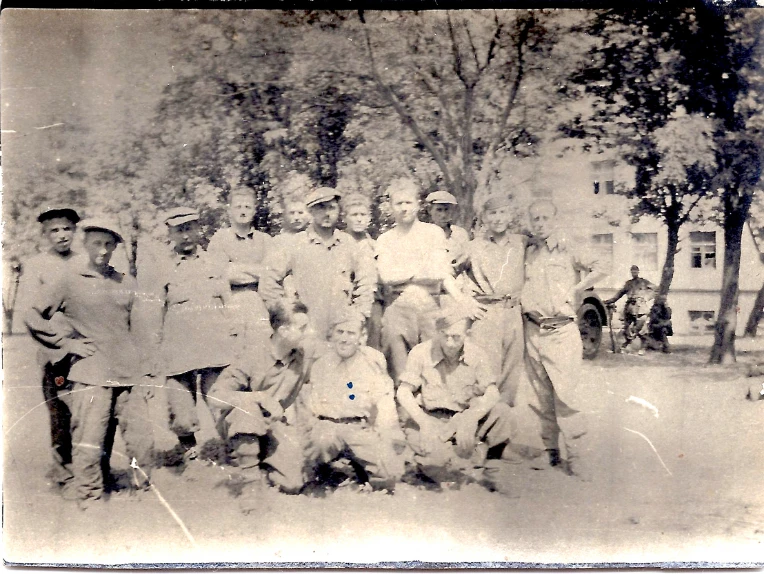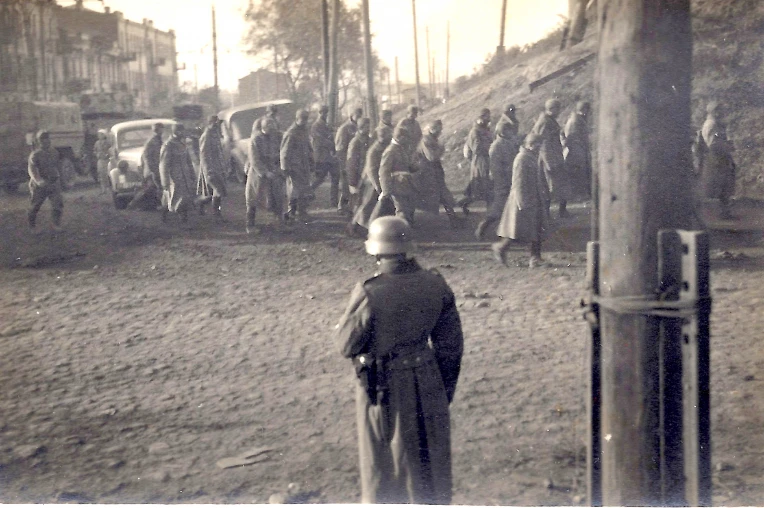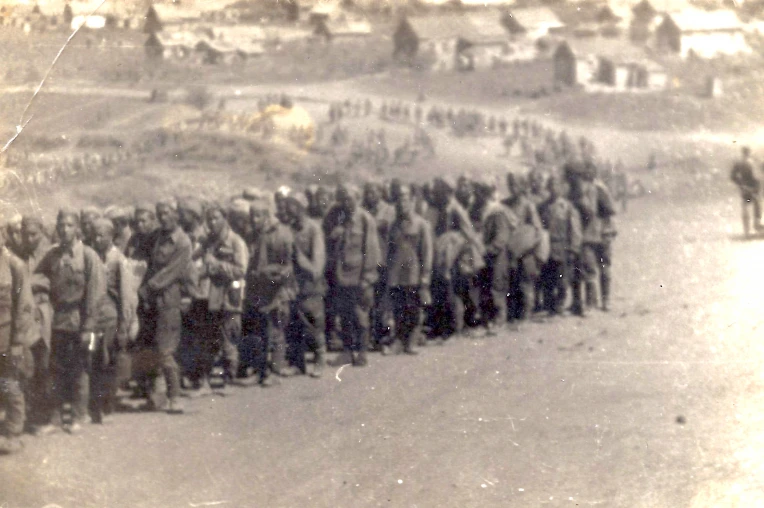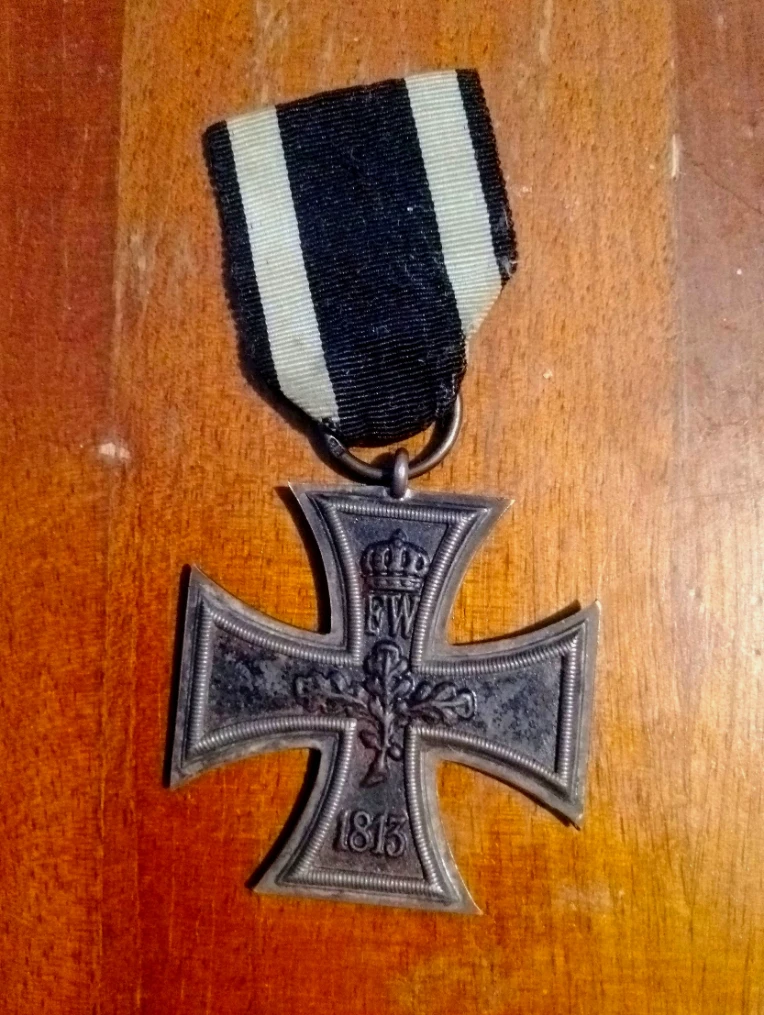Hello guys, I hope you are doing fine. As I mentioned in a previous journal I plan to post photos and talk a bit about them since I am removing them from FA after discovering I feel much more at home here with its amazing community. I want to start with a set of historical photos taken during WWII when my great uncle fought during Operation Barbarossa in Soviet Ukraine and Soviet Union (he was one of the few who managed to survive but he partially lost toe mobility because of frost).
Let's start with something simple:
The fallen fighter

This is a LaGG-3 "White 4-50" (Lavochkin-Gorbunov-Gudkov LaGG-3) shot down in 02/05/1942 in Stalino. With the help of my cool friend Szynka and this website I was able to identify the model. Despite its flaws and poor production quality, it was one of the backbones of the Soviet Airforce and laid the groundwork for one of the great fighters of the Great Patriotic War.
This was a single engine Soviet fighter. It was developed in 1938 under the name I-301 to replace Polikarpov I-16 and because there was a shortage of light alloys and steel, it was designed to be predominantly made of wood (delta-drevesina, a special chemically improved plywood that was particularly rugged and fire-resistant. The prototype was the LaGG-1 and took its maiden flight on March 1, 1940. It was underpowered and overweight — its Klimov M-105P engine could produce only 1050 hp at sea level, which was insufficient, and was also prone to oil leaks(1). Pilots reported that the plane generally had poor flying characteristics (it was prone to spin during steep turns, it would stall suddenly, and the landing gear were too fragile). Despite these flaws, it passed its trials and was ordered into production in November 1940(2).
By the time of the June 22, 1941 German invasion of the Soviet Union, 100 LaGG-3’s had been built. All units operating the new fighter were far from the front lines and escaped the initial onslaught. By the end of 1941, it was for a short period the most common fighter in the Soviet inventory, more numerous than either the Yak-1 or MiG-3(3). The main flaws of this plan were slow speed, heaviness and being underpowered but it has some good qualities too:
highly fire-resistant
very rugged
heavier armament than its German counterparts, the Messerschmitt Bf 109E and F
Another trait of this fighter is that it boasted one 20mm cannon firing through the propeller hub, two 7.62mm machine guns in the nose, and two 12.7mm machine guns in the wings — and all these guns were a significant contributing factor to the plane’s weight(4).
fun fact: in October 1941, a single LaGG-3 unit, the 21st Fighter Regiment more precisely, shot down 23 German aircraft while losing only seven of its own(5).
It became a a successful bomber interceptor, but despite this it couldn't compete with Bf 109, especially the F variant. It was easier to fly than the MiG-3 but it was quite unpopular among Soviet pilots who nicknamed it “Lakirovanny Garantirovanny Grob.” This was both a play on its abbreviated designation (LaGG) and a reference to its wooden construction that translated to “Guaranteed Varnished Coffin.”(6)
Other downfalls of this fighter were the fragile landing gear and quirky flight characteristics that made it have high accident rate and not recommended for inexperienced pilots. In comparison Yak-1 was more pilot-friendly. LaGG-3 production ended in 1944, but the Russians continued to fly the type for the duration of the war. It even saw action against Japanese forces in the Far East in the closing days of the war(7).
It's also interesting that the LaGG-3 was made into the superior La-5 by swapping out its water-cooled engine for a radial, when the Curtiss P-36 was developed into the superior P-40 by making the opposite swap^^
Another photo I want to share is this:
Soviet POWs

This photo taken on 30/06/1942. It comes from my grandfather's photo collection that was given to me as way to honour his memory but most of all I want to pay tribute to history. The photo was taken in Donetsk (at that time the city was called Stalino), et the start of World War II, the population of Stalino was 507,000. After the war, the population was 175,000. The invasion by Nazi Germany almost completely destroyed the city. It was occupied by German and Italian forces as part of the Reichskommissariat Ukraine between 16 October 1941 and 5 September 1943. Hopefully it was mostly rebuilt on a large scale after the war. These people were Soviet POWs forced to work on a warehouse, I only hope they managed to escape and avoid the worst but I highly doubt. History shall never be forgotten.
And now I want to share two of the most dark history photos I have:
Stammlager 348

What you are seeing is a line of Soviet POWs being sent in one of the camps of Dnipropetrovsk, the photo was taken on 06/10/1941. Dnipropetrovsk was under Nazi occupation from 26 August 1941 to 25 October 1943. The city was administered as part of the Reichskommissariat Ukraine. The Holocaust in Dnipropetrovsk reduced the city's remaining Jewish population, estimates for which range from 55,000 to 30,000, to just 702. As I said this is Stalag 348 where the occupiers are estimated to have killed upwards of 30,000 Soviet POWs. Rest in peace, everyone.
Here a list of all German stalag camps: https://www.pegasusarchive.org/pow/Stalag.htm
I wanted to share the history of another stalag 328 but sadly the website will be shut down the next year and I can't find the article anymore :(
Last but not least, the death march photo:
Todesmärsche in Woroschylowhrad

This photo shows a line of prisoners leaving a concentration camp in Woroschilowgrad or Voroshilovgrad, renamed on 5 November 1935 in honour of Soviet military commander and politician Kliment Voroshilov because the original name is Luhansk. The photo was taken on 25 July 1942 and I find this particularly interesting from a historical point of view since the city became a frontline city in World War II after the failure of Nazi Germany's Operation Barbarossa to capture major Soviet cities.
On July 17, 1942, Luhansk was captured by German invaders (Case Blue). At that time, an underground city committee of the party and a partisan unit were created in the city. I. M. Yakovenko, who previously worked as the second secretary of the Luhansk City Committee of the Communist Party of Ukraine, was approved as the secretary of the underground regional committee and city committee of the party and the commander of the partisan detachment. In the partisan detachment were the secretary of the underground regional committee of the Ukrainian Communist Party of Ukraine, N. Fesenko, and the secretary of the underground city Komsomol committee, H. Serikova. A wide network of temporary apartments is being created in Luhansk. More than 100 people were left for underground work and organizing sabotage in the city. In addition, on the instructions of the Central Committee of the Communist Party of Ukraine, the city committee of the party selected and sent 35 communists to other partisan units. 64 scouts were sent to the rear of the enemy.
From the first days of the occupation, underground party and Komsomol organizations began to actively operate in the city and adjacent areas. The partisan unit waged an armed struggle against the fascist occupiers in Luhansk, on the territory of Stanychno-Luhansk, Verkhnyoteplovsky, Oleksandrivsky, Novosvitlivskyi districts. Partisans made bold attacks on fascist troops, destroyed soldiers and officers, disabled enemy equipment, telephone lines, bridges, etc.
On September 15, 1942, German nazis discovered and surrounded a partisan detachment near the village of Pankivka. In an unequal battle, fighting to the last drop of blood, I.M. Yakovenko, squad leader P.P. Shevchenko, Komsomol member Yu. Oleksintsev and others died. But as a result of a fierce battle, the partisans managed to break through the enemy ring, and those who remained continued to fight against the occupiers, disrupting their measures, destroying enemy soldiers and officers, and equipment. A group of underground Komsomol members led by N. Fesenko was active in the city. This group included H. Serykova, H. Shvedkova, V. Tretyakevich, pioneer V. Pyatorkin and many others. They carried out the assignment of the underground city party committee, distributed leaflets and anti-fascist literature. On the task of the underground regional committee of the party, N. Fesenko and G. Serykov, through V. Tretyakevich, established a connection with the party-Komsomol underground of Krasnodon, with the "Young Guard" organization.
One of the forms of struggle of city workers against the occupiers was the sabotage of their military, economic and other activities. Workers evaded work in every possible way, hid their true specialties, and if they were forced to work, they damaged machines and prevented the start-up of industrial enterprises. The Nazis did not manage to restore the work of any city enterprise. On February 14 1943, Luhansk was liberated from the German invaders (Operation Gallop).
Nazis murdered 8,000 civilians, including women, children and the elderly. More than 10,000 Luhansk residents, mostly young people, were forcibly taken to hard labor in nazi Germany. So this photography depicts one of the hot spots moments of the conflicts where we see these poor people being forced to leave a concentration camp to be transferred to other locations since Soviet forces were likely to gain ground. May those soul rest in peace. Sorry for everything.
And now as last photo to conclude this first photographic journal an Iron Cross Class 2 I bought on E-Bay from a German seller:

Das Eisernes Kreuz ist ursprünglich eine preußische Kriegsauszeichnung und wurde am 10. März 1813 von König Friedrich Wilhelm III. für Auszeichnung im Befreiungskrieg gegen die Napoleonische Fremdherrschaft gestiftet. Ich habe das bei bei einem deutschen Verkäufer auf Ebay gekauft. Jedes Mal, wenn ich es ansehe, zolle ich der Person Tribut, die in einem blutrünstigen Krieg namens „Erster Weltkrieg“ gestorben ist.
(Yes, I am practicing a bit of German since I am studying it)
Ok, that's all for now. I hope you enjoyed this looooong reading and if the T rating is not enough due to the nature of the post, let me know in the comment and I will change to M. Bye and stay awesome!
References and footnotes:
(1) https://hangar47.com/lavochkin-gorbunov-gudkov-lagg-3/
(2) ibidem
(3) ibidem
(4) https://hangar47.com/lavochkin-gorbunov-gudkov-lagg-3/
(5) ibidem
(6) ibidem
(7) ibidem
Soviet Combat Aircraft of the Second World War Volume One: Single-Engined Fighters - Yefim Gordon and Dmitri Khazanov - ISBN 1-85780-083-4
LaGG & Lavochkin Aces of World War 2 - George Mellinger - ISBN 1-84176-609-7